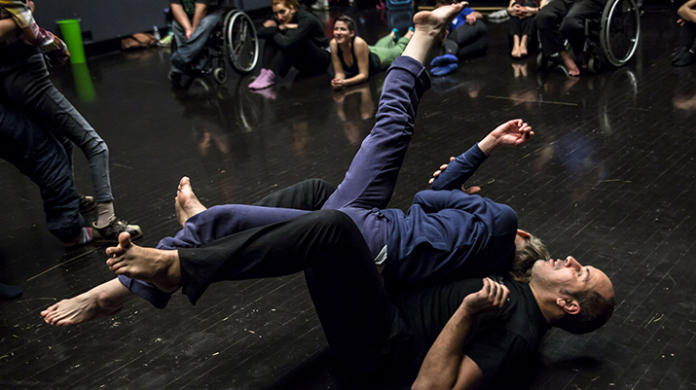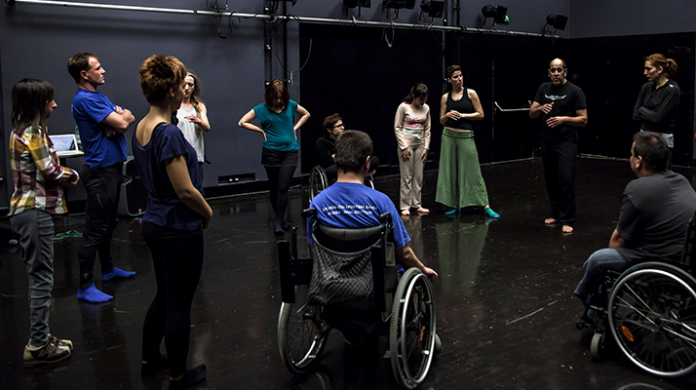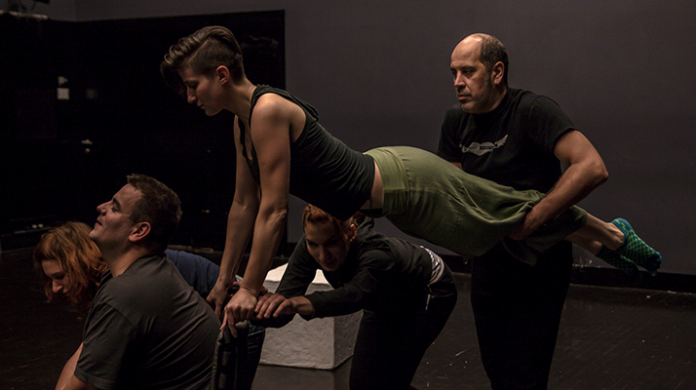Dancing with diversity
First Steps
I was first introduced to integrated dance when I lived in London in 1994. I was working with DV8 and, one day, they sent me to a physical theatre workshop with a company called Candoco and I met David Toole.
It was the first time I’d ever worked with people in wheelchairs – it was a very inspiring and renewing experience for me. I had to use all my experience as a dancer, and employ all the tools I have to work with in terms of creation – of moving with the body – to put it into play with the group. It was fantastic.
At first, for a few seconds I thought, “What am I going to do?”. But, suddenly, I realised – I just need to know them, to practice.
So, the first thing we did was to find a way to work and get to know each other’s bodies through games and play with the body; for me, as well them, to learn what to do, and how move with a dancer in a wheelchair or who doesn’t have legs. And through that we managed to do great work.
At the time, it felt a bit like being a boy or a little baby again. I had to start to experience something new I needed to discover. That was the starting point because I met Adam Benjamin [founder of Candoco]. We built up a very strong artistic relationship and friendship, at the same time.
When I went back to Barcelona in 2001, I learned my friend, a dancer, Adolfo Colmenares, had lost his sight because of an illness, retinitis, and was now blind. He’d already been out of the performing scene for five years and he asked me if I wanted to do something. I said, “Yes, why not?”
We did a project together, Face It, with other dancers, and it was completely fantastic – so we created another piece together called B2O. That’s when I thought, I wanted to get into this more and start digging deeper in the field.
Dance lessons with Adam
Through working with Candoco, I met Graeae [pioneering theatre company working with disabled artists] and saw several of their shows. I felt there was a gap in Barcelona, a hole to fill. I knew people who were working with disability in theatre, but not really in the arts of movement.
I invited Adam to Spain several times and we started creating integrated dance workshops in Barcelona. Little by little, a community grew, which became quite big and strong. Led by Adam - my master - the community began developing their own work, and was open to other influences and tutors from different fields of dance, and to understanding dance and movement differently.
Our work in Barcelona welcomes anyone with any kind of diversity; it could be physical diversity, emotional, intellectual, sensual, sexual, generational – it’s very open.
I really believe that you can learn from everybody, and as an artist, I learn a lot from the people I work with in the workshops.
My Unlimited Access Experience
From what I’ve tasted of Unlimited Access, it’s a project which enables people to exchange experience and connect with different countries – it’s in Croatia, Greece, Portugal and the UK. It allows you to learn about others' experiences – and compare them to your own country.
It’s been very interesting to talk to people in Zagreb, not only in terms of artistic creativity, but to have the chance to talk about the social issues people with disabilities confront in everyday life, outside the environment of the workshop, within family, society and politics. I think it’s really valuable to exchange information and exchange experiences.
Two years ago, I worked in Zagreb with some of the same participants as now. Unlimited Access has shown me how much the integrated dance collective in Zagreb has developed in that time and how it’s changed its approach to movement and to dance – they have really developed very talented skills.
It’s important to point out, Unlimited Access is just an embryo for something to develop, to take care of – it’s like a plant. And you need to water it, so it keeps growing. You won’t get a flower in a week or a month. It needs to be encouraged to grow and to last. It’s a matter of practice and continuity. I believe in that very much.
Choreographing Difference
I’ve been working as a dancer for the last 20 years, and only five with mixed abilities. I surprised myself with how I move and make discoveries in movement – I never would have found this had I only worked with able bodied dancers.
While working with people with different disabilities, I very quickly realised that we share something in common which is strong, and equal for both of us: how to cope with space.
People with disabilities move through spaces with obstacles, they need to deal with the space and develop strategies to move around. We able bodied dancers need to do that as well, in different ways, but it’s something that we really share, we all pay acute attention to space. We share certain things – that creates rhythm.
I always say, it’s not working with disabilities, it’s working with other abilities.
What’s clear is disabled performers have abilities that you do not. Like for instance, performers in wheelchairs can move faster on their wheels than I ever could with my legs – they can slide. It’s magical.
It’s just a matter of sensitivity; in many places around the world, people with disabilities are swept under the carpet. They’re at home, you don’t see them, but they are there, of course. It’s something that is quite taboo.
I know that many professional dancers are a bit suspicious, or fearful, of integrated dance, and I can understand because as dancers we look for the lines, we look for perfect bodies, but it’s a matter of learning a different aesthetics of movement and dance. For me, it’s about observation. You find another way to see, and you make interesting connections, you learn about the weight of the body and how it moves.
I found different ways to approach the language of movement. I need to adapt my body to something different, genuine; it could be a crutch, a wheel chair, a prosthesis.
I learn a lot from that; another sense of balance, how you find a dynamic together – it very much spans the entire spectrum of the approach to dance and you discover that everyone has their own capabilities to work with.
Connect with Jordi via Twitter @jordikiakaha or at jordikiakaha@gmail.com
Unlimited Access is a Europe-wide dance and dance theatre project designed to support best practice in the commissioning, creation, dissemination and programming of performing arts by disabled artists.
For more information, and to follow future Creative Encounters in Greece and Portugal in 2014, follow the hashtag #ULAccess on Twitter and Facebook.


